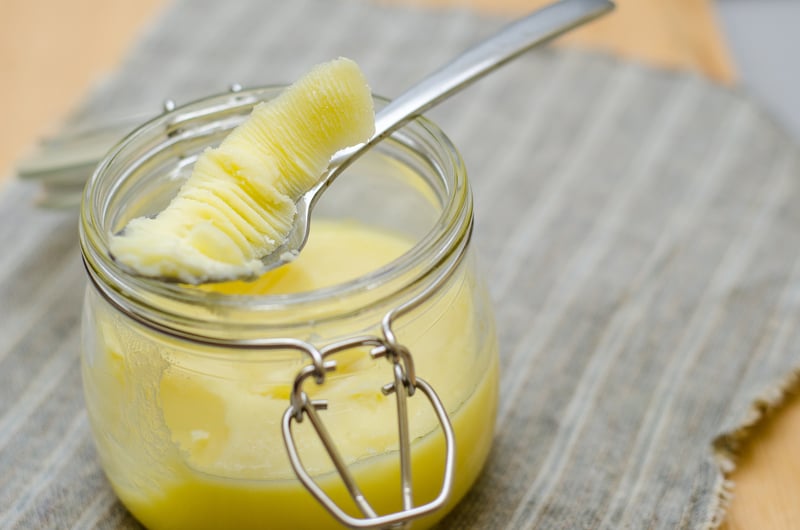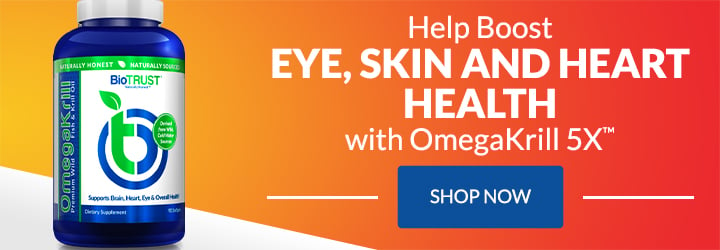Ghee vs. Butter: Which Is Healthier For You?

We’ve fortunately overcome the low-fat mania of the 1980s, finally understanding how important fat is to a healthy diet. That said, there’s still a lot of debate over which fats to choose: animal-based vs. plant, saturated vs. unsaturated, or if you’re really getting down to the dish, ghee vs. butter.
Ghee and butter are both made from milk, typically cow though goat and sheep butter are also available, and in some parts of the world, buffalo and yak butter are common. So, some consider them about equal. However, they do have differences. In the ghee vs. butter debate, which one is healthier? And are there times when one is better than the other?
Ghee vs. Butter: What Is It?
Most of us know that butter is the fat and protein globules made from churned cream. This dairy product is semi-solid at room temperature and can be used as a spread or condiment or added as a rich, creamy ingredient when frying, cooking, or baking. Ghee takes it a step (or two) further by clarifying the butter to remove the water and milk solids. This makes ghee a more concentrated fat than butter.
Ghee is found in many Indian or Pakistani recipes and has been part of those cooking cultures for thousands of years. Ghee itself is derived from the Sanskrit word that translates to “sprinkled.” It’s also used traditionally in other Asian cooking as a cooking oil and in other recipes.
It became popular in areas where the weather can get warm, which leads to butter spoiling. Ghee is more resistant as it doesn’t need to be refrigerated and can be kept in the pantry at room temp for weeks. However, if the temperatures are cooler, ghee turns solid, similar to coconut oil.
While cooking is the main reason to use ghee, it’s also part of Ayurveda, an ancient form of medicine. In this practice, it’s often called ghrita or medicated ghee, which takes the clarified butterfat and blends it with various herbs for therapeutic purposes. For example, it’s used as a base in Ayurvedic massage or herbal ointments to relieve painful burns and rashes.
Ghee vs. Butter: Nutrition Facts
While butter and ghee are very similar, there are slight differences in nutrition. Here’s how it breaks down per tablespoon of each:
Butter Nutrition Facts
- Calories: 100
- Fat: 11
- Saturated Fat: 7
- Monounsaturated Fat: 3
- Polyunsaturated Fat: .5
Ghee Nutrition Facts
- Calories: 123
- Fat: 14
- Saturated Fat: 9
- Monounsaturated Fat: 4
- Polyunsaturated Fat: .5
Both have only trace amounts of protein and carbs and instead get nearly 100% of their calories from fat. Ghee, however, does have a higher concentration and also provides slightly more butyric acid (which may support healthier inflammation levels and improved digestive health), other short-chain saturated fat, conjugated linoleic acid (which may support healthy cholesterol levels and weight loss), and vitamin A (which supports eye and skin health as well as immunity) than butter. However, the differences are minor, so choosing one over the other likely will have few health effects.
Ghee is also milk-free, which means it contains virtually no lactose or casein, which some people are unable to tolerate well. If you are sensitive to milk products or have an allergy, ghee may be the safer option as butter contains small amounts of both. In addition, ghee is a rich source of omega-3 fatty acids.
How to Make Ghee
You can buy ghee at many grocery stores, natural food stores, health-food co-ops, or online. Or you can easily make it from grass-fed butter.
To make ghee, start by melting unsalted butter in a saucepan or skillet over low heat until the water and milk solid portions separate from the fat. Use a slotted spoon to remove any foam or milk solids from the top. Once the liquid evaporates, the milk solids settle to the bottom and then cook to a lovely golden brown and start smelling rich and nutty. (This takes around 15 to 20 minutes and is what differentiates ghee from clarified butter.) Turn off the heat and allow the remaining oil (i.e., the ghee) to cool until it’s warm rather than hot or cold. Then strain it through a cheesecloth or coffee filter before transferring it into your preferred glass jar or container.
You can store your ghee for around three or so months or in the fridge for up to a year. If the ghee develops a sour smell, it’s time to discard as it’s no longer safe to consume.
Ghee vs. Butter: What is Better to Cook With?
Both butter and ghee have numerous culinary uses. For example, butter works well in most baked recipes or as a spread for its creamy, sweet flavor.
Ghee has a higher smoke point, up to 485 degrees F (252˚C), which means it can handle a higher temperature before becoming volatile. It also produces less acrylamide, a toxic substance created when vegetable or seed oils are heated to high levels.
Ghee can be used for sauteing, baking, frying, dipping, and drizzling. It’s also known for its smoky-sweet, creamy texture to add to “bulletproof” or keto-friendly coffee. Some ghee is made with fermented cream or yogurt (cultured ghee) and has a tangier taste. Other varieties have added garlic, chilis, or other herbs for flavor and work well as spreads for bread or for drizzling over roasted vegetables. No matter which variety you choose, ghee is not typically recommended for baking.
Ghee vs. Butter: Drawbacks
Both butter and ghee are sources of saturated fats, and people respond to these types of fats differently. For example, people who already have high levels of LDL cholesterol can react negatively to higher levels of saturated fats and therefore may want to limit their intake of ghee and butter to no more than two tablespoons per day.
There are also some concerns that because ghee is subjected to high levels of heat, the fat may oxidize, and oxidized fat is linked to an increased risk of heart disease. Fresh butter has a lower risk of being oxidized.
Which is Healthier?
Butter is just a bit lower in calories; however, you need to use less ghee in recipes. Ghee provides more nutrients, but only slightly. Ghee is also more likely to oxidize, so it may be less appropriate for those concerned with their blood lipid levels. Yet, it’s a bit better for anyone who has a dairy intolerance.
In other words, choosing ghee vs. butter will likely come down to the recipe you’re making rather than which one is healthier. Little evidence suggests that either is significantly more beneficial. Both can be part of a healthy diet when used in moderation. Indeed, a little butter or ghee goes a long way and can impart a lot of flavor and satisfaction in a very small serving.




 7 Signs Your Body is Seriously Low on Collagen (not just wrinkles)
7 Signs Your Body is Seriously Low on Collagen (not just wrinkles) Health Expert: "Turmeric Doesn't Work (unless...)"
Health Expert: "Turmeric Doesn't Work (unless...)" 3 Warning Signs Your Probiotic Supplement is a Total Waste
3 Warning Signs Your Probiotic Supplement is a Total Waste

